The Unexplored Link between Communication and Trust in Aviation Maintenance Practice
Abstract
1. Introduction
2. Basic Communication Theory
- The presentational media. The body language, the oral speech, the facial expressions are providing communication. This requires the physical presence of the communicator as he/she is the medium and communication happens in real-time.
- The representational media. Any medium that represents the above by the production of a text, picture, painting, piece of art. These media do not require the presence of the communicator as they can act independently.
- The mechanical media. These media utilize technologically developed channels; therefore, they are transmitters of the presentation and representation media. Examples are: radio, television, computers, and telephones.
2.1. Miscommunication
2.2. Areas in Aviation Maintenance Prone to Communication Failure
2.3. Communication in Aviation Training
3. Trust
3.1. Trust Dynamics within the Organization
3.2. Characteristics of Trust
- “My supervisor can be trusted”
- “My safety ideas would be acted on if reported to supervisor”.
- “My supervisor protects confidential information.”.
4. The Relation between Trust and Communication
5. Discussion and Conclusions
Author Contributions
Funding
Conflicts of Interest
References
- Dhillon, B.S.; Liu, Y. Human Error in Maintenance: A Review. J. Qual. Maint. Eng. 2006, 12, 21–36. [Google Scholar] [CrossRef]
- Reason, J.T. Managing the Risks of Organizational Accidents; Ashgate: Farnham, UK, 1997. [Google Scholar]
- European Aviation Safety Agency. Annual Safety Review 2014; European Aviation Safety Agency: Cologne, Germany, 2015. [Google Scholar]
- Blaise, J.-C.; Levrat, E.; Iung, B. Process Approach-Based Methodology for Safe Maintenance Operation: From Concepts to SPRIMI Software Prototype. Saf. Sci. 2014, 70, 99–113. [Google Scholar] [CrossRef]
- Chang, Y.-H.; Wang, Y.-C. Significant Human Risk Factors in Aircraft Maintenance Technicians. Saf. Sci. 2010, 48, 54–62. [Google Scholar] [CrossRef]
- Dupont, G. The Dirty Dozen Errors in Maintenance. In Proceedings of the 11th Symposium on Human Factors in Maintenance and Inspection: Human Error in Aviation Maintenance, Washington, DC, USA, 12–13 March 1997. [Google Scholar]
- Flin, R.; O’Connor, P.; Mearns, K. Crew Resource Management: Improving Team Work in High Reliability Industries. Team Perform. Manag. Int. J. 2002, 8, 68–78. [Google Scholar] [CrossRef]
- Marquardt, N.; Gades, R.; Robelski, S. Implicit Social Cognition and Safety Culture. Hum. Factors Ergon. Manuf. Serv. Ind. 2012, 22, 213–234. [Google Scholar] [CrossRef]
- Wise, J.A.; Hopkin, V.D.; Garland, D.J. Handbook of Aviation Human Factors; CRC Press: Boca Raton, FL, USA, 2010. [Google Scholar]
- Reiman, T. Understanding Maintenance Work in Safety-Critical Organisations-Managing the Performance Variability. Theor. Issues Ergon. Sci. 2011, 12, 339–366. [Google Scholar] [CrossRef]
- Federal Aviation Administration. Addendum—Chapter 14: Human Factors. In Aviation Maintenance Technical Handbook FAA-H-8083-30; US Department of Transportation: Oklahoma City, OK, USA, 2011. [Google Scholar]
- Silvagni, S.; Napoletano, L.; Graziani, I.; Blaye, P.L.; Rognin, L. Concept for Human Performance Envelope; EU Horizon 2020 Research and Innovation Programme: Brussels, Belgium, 2015. [Google Scholar]
- Whitener, E.M.; Brodt, S.E.; Korsgaard, M.A.; Werner, J.M. Managers as Initiators of Trust: An Exchange Relationship Framework for Understanding Managerial Trustworthy Behavior. Acad. Manag. Rev. 1998, 23, 513–530. [Google Scholar] [CrossRef]
- Hernandez, J.M.d.C.; Santos, C.C.d. Development-Based Trust: Proposing and Validating a New Trust Measurement Model for Buyer-Seller Relationships. BAR Braz. Adm. Rev. 2010, 7, 172–197. [Google Scholar] [CrossRef]
- Bachmann, R. The Coordination of Relations Across Organizational Boundaries. Int. Stud. Manag. Org. 2003, 33, 7–21. [Google Scholar] [CrossRef]
- Carrière, J.; Bourque, C. The Effects of Organizational Communication on Job Satisfaction and Organizational Commitment in a Land Ambulance Service and the Mediating Role of Communication Satisfaction. Career Dev. Int. 2009, 14, 29–49. [Google Scholar] [CrossRef]
- Cascio, W.F. Managing a Virtual Workplace. Acad. Manag. Exec. 2000, 14, 81–90. [Google Scholar] [CrossRef]
- Cho, Y.J.; Park, H. Exploring the Relationships Among Trust, Employee Satisfaction, and Organizational Commitment. Public Manag. Rev. 2011, 13, 551–573. [Google Scholar] [CrossRef]
- Flin, R. Measuring Safety Culture in Healthcare: A Case for Accurate Diagnosis. Saf. Sci. 2007, 45, 653–667. [Google Scholar] [CrossRef]
- Muchinsky, P.M. An Intraorganizational Analysis of the Roberts and O’Reilly Organizational Communication Questionnaire. J. Appl. Psychol. 1977, 62, 184–188. [Google Scholar] [CrossRef]
- Shapiro, D.B.; Sheppard, H.; Cheraskin, L. Business on a Handshake. Negot. J. 1992, 8, 365–377. [Google Scholar] [CrossRef]
- Yeager, S.J. Measurement of Independent Variables Which Affect Communication: A Replication of Roberts and O’Reilly. Psychol. Rep. 1978, 43, 1319–1324. [Google Scholar] [CrossRef]
- Shannon, C.; Weaver, W. The Mathematical Theory of Communication; University of Illinois Press: Champaign, IL, USA, 1949. [Google Scholar]
- Fiske, J. Introduction to Communication Studies (Studies in Culture and Communication); Taylor & Francis Group/Books: London, UK, 1990. [Google Scholar]
- Berelson, B.; Steiner, G. Human Behavior: An Inventory of Scientific Findings; Harcourt, Brace, and World: Oxford, UK, 1964; p. 527. [Google Scholar]
- Ayer, A.J. What is Communication? J. Commun. 1955, 9, 13. [Google Scholar]
- Schramm, W. How Communication Works. In The Process and Effects of Mass Communication; University of Illinois Press: Champaign, IL, USA, 1954; pp. 3–26. [Google Scholar]
- Duncan, T.; Moriarty, S.E. A Communication-Based Marketing Model for Managing Relationships. J. Mark. 1998, 62, 1–13. [Google Scholar] [CrossRef]
- Kanki, B.G.; Helmreich, R.L.; Anca, J. Communication and Crew Resource Management. In Crew Resource Management, 2nd ed.; Academic Press: London, UK, 2010; pp. 111–146. [Google Scholar]
- Anolli, L.; Ciceri, R.; Riva, G. Say not to Say: New Perspectives on Miscommunication; IOS Press: Washington, DC, USA, 2002; Volume 3. [Google Scholar]
- Parret, H. Indirection, Manipulation and Seduction in Discourse. In Pretending to Communicate; Walter De Gruyter GmbH: Berlin, Germany, 1994. [Google Scholar]
- Mortensen, C.D. Miscommunication, 1st ed.; Oaks, T., Ed.; Sage Publications: London, UK, 1997. [Google Scholar]
- Shukri, S.A.; Millar, R.M.; Gratton, G.; Garner, M. The Potential Risk of Communication Media in Conveying Critical Information in the Aircraft Maintenance Organisation: A Case Study. IOP Conf. Ser. Mater. Sci. Eng. 2016, 152, 012044. [Google Scholar] [CrossRef]
- Cushing, S. Fatal Words: Communication Clashes and Aircraft Crashes; University of Chicago Press: Chicago, IL, USA, 1994. [Google Scholar]
- Dismukes, R.K. (Ed.) Human Error in Aviation; Routledge: London, UK, 2009. [Google Scholar]
- Balk, A.D.; Bossenbroek, J.W. Aircraft Ground Handling and Human Factors. A Comparative Study of the Perceptions by Ramp Staff and Management; NLR Air Transport Safety Institute: Amsterdam, The Netherlands, 2010. [Google Scholar]
- Drury, C.G. Human Factors in Aircraft Maintenance; RTO AVT Lecture Series: Sofia, Boulgaria, 2000; pp. 15-1–15-9. [Google Scholar]
- McFadden, K.L.; Towell, E.R. Aviation Human Factors: A Framework for the New Millennium. J. Air Transp. Manag. 1999, 5, 177–184. [Google Scholar] [CrossRef]
- Graham, S.; Bonacum, D.; Leonard, M. The Human Factor: The Critical Importance of Effective Teamwork and Communication in Providing Safe Care. Qual. Saf. Health Care 2004, 13, 85–90. [Google Scholar]
- Lautman, L.; Gallimore, P. Control Caused Accident: Results of a 12-Operator Survey; Boeing Commercial Airplane Co.: Seattle, WA, USA, 1987. [Google Scholar]
- Wiegmann, D.A.; Shappell, S.A. Human Error and Crew Resource Management Failures in Naval Aviation Mishaps: A Review of US Naval Safety Cetre Data, 1990–1996. Aviat. Space Environ. Med. 1999, 70, 1147–1151. [Google Scholar] [PubMed]
- Yacavone, D.W. Mishap Trends and Cause Factors in Naval Aviation: A Review of Naval Safety Center data. Aviat. Space Environ. Med. 1993, 64, 392–395. [Google Scholar]
- Wiegmann, D.A.; Shappell, S.A. A Human Error Approach to Aviation Accident Analysis: The Human Factors Analysis and Classification System; Burlington, V.T., Ed.; Ashgate: Aldershot, UK, 2003. [Google Scholar]
- Murphy, P. The Role of Communications in Accidents and Incidents during Rail Possessions. In Engineering Psychology and Cognitive Ergonomics Volume Five Aerospace and Transportation Systems; Harris, D., Ed.; Ashgate: Aldershot, UK, 2001. [Google Scholar]
- Rail Safety Standards Board. Railway Group Safety Plan; Rail Safety Standards Board: London, UK, 2003. [Google Scholar]
- Caldwell, J.A. Fatigue in Aviation. Trav. Med. Infect. Dis. 2005, 3, 85–96. [Google Scholar] [CrossRef] [PubMed]
- Mattson, M.; Petrin, D.A.; Young, J.P. Integrating Safety in the Aviation System: Interdepartmental Training for Pilots and Maintenance Technicians. J. Air Transp. World Wide 2001, 6, 37–64. [Google Scholar]
- National Transportation Safety Board (NTSB). Aircraft Accident Report—In-Flight Loss of Propeller Blade Forced Landing and Collision with Terrain, Atlantic Southeast Airlines, Inc., Flight 529, Embraer EMB-120RT, N256AS; NTSB: Washington, DC, USA, 1996. [Google Scholar]
- Bonnefon, J.F.; Feeney, A.; De Neys, W. The Risk of Polite Misunderstandings. Curr. Dir. Psychol. Sci. 2011, 20, 321–324. [Google Scholar] [CrossRef]
- Taylor, J.C.; Thomas, R.L., III. Written Communication Practices as Impacted by a Maintenance Resource Management Training Intervention. J. Air Transp. 2003, 8, 69–90. [Google Scholar]
- Von Thaden, T.L.; Wiegmann, D.A.; Shappell, S.A. Organizational Factors in Commercial Aviation Accidents. Int. J. Aviat. Psychol. 2006, 16, 239–261. [Google Scholar] [CrossRef]
- Ward, M.E.; McDonald, N.; Morrison, R.; Gaynor, D.; Nugent, T. A Performance Improvement Case Study in Aircraft Maintenance and Its Implications for Hazard Identification. Ergonomics 2010, 53, 247–267. [Google Scholar] [CrossRef]
- Sogg, S. An Integrated Systems Approach to Human Factors in Commercial Aviation Maintenance Systems; Aviation Maintenance Symposium: San Francisco, CA, USA, 2002. [Google Scholar]
- Drury, C.G.; Guy, K.P.; Wenner, C.A. Outsourcing Aviation Maintenance: Human Factors Implications, Specifically for Communications. Int. J. Aviat. Psychol. 2010, 20, 124–143. [Google Scholar] [CrossRef]
- Drury, C.G.; Johnson, W.B. Writing Aviation Maintenance Procedures That People Can/Will Follow. In Proceedings of the Human Factors and Ergonomics Soiety 57th Annual Meeting, San Diego, CA, USA, 3 October 2013. [Google Scholar]
- Kraus, D.C.; Gramopadhye, A.K. Effect of Team Training on Aircraft Maintenance Technicians: Computer-Based Training Versus Instructor-Based Training. Int. J. Ind. Ergon. 2001, 27, 141–157. [Google Scholar] [CrossRef]
- Liang, G.-F.; Lin, J.-T.; Hwang, S.-L.; Wang, E.M.-Y.; Patterson, P. Preventing Human Errors in Aviation Maintenance Using an On-Line Maintenance Assistance Platform. Int. J. Ind. Ergon. 2010, 40, 356–367. [Google Scholar] [CrossRef]
- Chaparro, A.; Groff, L.S. Human Factors Survey of Aviation Maintenance Technical Manuals. In 16th Human Factors in Aviation Maintenance Symposium; Embry-Riddle Aeronautical University Scholarly Commons: San Francisco, CA, USA, 2002. [Google Scholar]
- Chervak, S.; Drury, C.G.; Ouellette, J.P. Simplified English for Aircraft Workcards. Hum. Factors Ergon. Soc. Annu. Meet. Proc. 1996, 40, 303–307. [Google Scholar] [CrossRef]
- Karanikas, N.; Soltani, P.; Boer, R.J.; Roelen, A.L.C. Safety Culture Development: The Gap Between Industry Guidelines and Literature, and the Differences Amongst Industry Sectors. In Advances in Safety Management and Human Factors: Proceedings of the AHFE 2016 International Conference on Safety Management and Human Factors; Springer International Publishing: Orlando, FL, USA, 2016. [Google Scholar]
- Parke, B.; Kanki, B.G. Best Practices in Shift Turnovers: Implications for Reducing Aviation Maintenance Turnover Errors as Revealed in ASRS Reports. Int. J. Aviat. Psychol. 2008, 18, 72–85. [Google Scholar] [CrossRef]
- Tannenbaum, S.I.; Cerasoli, C.P. Do Team and Individual Debriefs Enhance Performance? A Meta-Analysis. Hum. Factors 2013, 55, 231–245. [Google Scholar] [CrossRef] [PubMed]
- Patankar, M.S.; Taylor, J.C. MRM Training, Evaluation, and Safety Management. Int. J. Aviat. Psychol. 2008, 18, 61–71. [Google Scholar] [CrossRef]
- Salas, E.; Burke, C.S.; Bowers, C.A.; Wilson, K.A. Team Training in the Skies: Does Crew Resource Management (CRM) Training Work? Hum. Factors 2001, 43, 641–674. [Google Scholar] [CrossRef]
- Taylor, J.C.; Patankar, M.S. Four Generations of MRM: Evolution of Human Error Management Programs in the United States. J. Air Transp. World Wide 2001, 6, 3–32. [Google Scholar]
- Lappas, I.; Kourousis, K.I. Anticipating the Need for New Skills for the Future Aerospace and Aviation Professionals. J. Aerosp. Technol. Manag. 2016, 8, 232–241. [Google Scholar] [CrossRef]
- Salas, E.; Tannenbaum, S.I.; Kraiger, K.; Smith-Jentsch, A.K. The Science of Training and Development in Organizations: What Matters in Practice. Psychol. Sci. Public Interest Suppl. 2012, 13, 74–101. [Google Scholar] [CrossRef]
- Karanikas, N. Using Reliability Indicators to Explore Human Factors Issues in Maintenance Databases. Int. J. Qual. Reliab. Manag. 2013, 30, 116–128. [Google Scholar] [CrossRef]
- Kirkpatrick, D. Evaluating Training Programs: The Four Levels; Berrett-Koehler: San Francisco, CA, USA, 1998. [Google Scholar]
- Ribeiro, B.; Filipe, P. Dissemination, Exploitation and Communication; EU’s Horizon 2020 Research and Innovation Programme: Brussels, Belgium, 2016. [Google Scholar]
- Karanikas, N. Human Error Views: A Framework for Benchmarking Organizations and Measuring the Distance between Academia and Industry. In Proceedings of the 49th ESReDA Seminar, Brussels, Belgium, 29–30 October 2015. [Google Scholar]
- Malagas, K.; Fragoudaki, A.; Kourousis, K.I.; Nikitakos, N. The Prospects of the Higher Education Aviation Programs in Greece: A Missed Opportunity or a Challenge to Meet? J. Aerosp. Technol. Manag. 2017, 9, 510–518. [Google Scholar] [CrossRef]
- Robinson, S.L. Trust and Breach of the Psychological Contract. Adm. Sci. Q. 1996, 41, 574–599. [Google Scholar] [CrossRef]
- Butler, J.K.J. Towards Understanding and Measuring Conditions of Trust: Evolution of a Conditions of Trust Inventory. J. Manag. 1991, 17, 643–663. [Google Scholar] [CrossRef]
- Mayer, R.C.; Davis, J.H.; Schoorman, F.D. An Integrative Model of Organizational Trust. Acad. Manag. Rev. 1995, 20, 709–734. [Google Scholar] [CrossRef]
- Cox, S.; Jones, B.; Collinson, D. Trust Relations in High-Reliability Organizations. Risk Anal. 2006, 26, 1123–1138. [Google Scholar] [CrossRef]
- O’Reilly, C.A. Supervisors and Peers as Information Sources, Group Supportiveness, and Individual Decision-Making Performance. J. Appl. Psychol. 1977, 62, 632–635. [Google Scholar] [CrossRef]
- O’Reilly, C.A.; Roberts, K.H. Task Group Structure, Communication, and Effectiveness in Three Organizations. J. Appl. Psychol. 1977, 62, 674–681. [Google Scholar] [CrossRef]
- Axelrod, R. The Evolution of Cooperation; Basic Books: New York, NY, USA, 1984. [Google Scholar]
- Deutsch, M. Cooperation and Trust: Some Theoretical Notes. In Nebraska Symposium on Motivation; University of Nebraska Press: Lincoln, NE, USA, 1962. [Google Scholar]
- Earley, P.C. Trust, Perceived Importance of Praise and Criticism, and Work Performance: An Examination of Feedback in the United States and England. J. Manag. 1986, 12, 457–473. [Google Scholar] [CrossRef]
- Ben-Ner, A.; Putterman, L. Trust, Communication and Contracts: An Experiment. J. Econ. Behav. Organ. 2009, 70, 106–121. [Google Scholar] [CrossRef]
- McAllister, D.J. Affect-And Cognition-Based Trust as Foundations for Interpersonal Cooperation in Organizations. Acad. Manag. J. 1995, 38, 24–59. [Google Scholar]
- Zand, D.E. Trust and Managerial Problem Solving. Adm. Sci. Q. 1972, 17, 229–239. [Google Scholar] [CrossRef]
- Harvey, C.; Stanton, N.A. Safety in System-Of-Systems: Ten Key Challenges. Saf. Sci. 2014, 70, 358–366. [Google Scholar] [CrossRef]
- Taylor, J.C.; Thomas, R.L., III. Toward Measuring Safety Culture in Aviation Maintenance: The Structure of Trust and Professionalism. Int. J. Aviat. Psychol. 2003, 13, 321–343. [Google Scholar] [CrossRef]
- Reason, J.T. Organizational Accidents Revisited; CRC Press: Boca Raton, FL, USA; London, UK, 2016. [Google Scholar]
- Dekker, S. Drift into Failure: From Hunting Broken Components to Understanding Complex Systems; Ashgate: Farnham, UK; Burlington, VT, USA, 2011. [Google Scholar]
- Rasmussen, J. Risk Management in a Dynamic Society: A Modelling Problem. Saf. Sci. 1997, 27, 183–213. [Google Scholar] [CrossRef]
- Leveson, N. A New Accident Model for Engineering Safer Systems. Saf. Sci. 2004, 42, 237–270. [Google Scholar] [CrossRef]
- Jian, J.-Y.; Bisantz, A.M.; Drury, C.G. Towards an Empirically Determined Scale of Trust in Computerized Systems: Distinguishing Concepts and Types of Trust. Proc. Hum. Factors Ergon. Soc. 1998, 1, 501–505. [Google Scholar] [CrossRef]
- Ockerman, J.; Pritchett, A. A Review and Reappraisal of Task Guidance: Aiding Workers in Procedure Following. Int. J. Cogn. Ergon. 2000, 4, 191–212. [Google Scholar] [CrossRef]
- Patankar, M.S.; Gomez, M. Maintenance ASAP Programs: Barriers and Opportunities; Federal Aviation Agency (FAA): Washington, DC, USA, 2004.
- McKnight, D.H.; Thatcher, J.B. Trust in Technology: Development of a Set of Constructs and Measures. In Handbook of Trust Research; Zaheer, A., Bachmann, R., Eds.; American Psychological Association: Washington, DC, USA, 2004. [Google Scholar]
- McKnight, D.H.; Carter, M.; Thatcher, J.B.; Clay, P. Trust in a Specific Technology: An Investigation of Its Components and Measures. ACM Trans. Manag. Inf. Syst. 2011, 2, 1–25. [Google Scholar] [CrossRef]
- McKnight, D.H.; Chervany, N.L. The Meanings of Trust. In MIS Research Center Working Paper Series; University of Minnesota: Minneapolis, MN, USA, 1996. [Google Scholar]
- Powell, W.W.; DiMaggio, P.J. The New Institutionalism in Organizational Analysis; University of Chicago Press: Chicago, IL, USA, 1991. [Google Scholar]
- Giddens, A. The Consequences of Modernity; John Wiley & Sons: New Jersey, NJ, USA, 1990. [Google Scholar]
- Salam, M.A. The Mediating Role of Supply Chain Collaboration on the Relationship between Technology, Trust and Operational Performance. Benchmarking Int. J. 2017, 24, 298–317. [Google Scholar] [CrossRef]
- Arrow, K. The Limits of Organization; Norton: New York, NY, USA, 1974. [Google Scholar]
- Zaheer, A.; Bachmann, R. Handbook of Trust Research. Elgar Original Reference; Edward Elgar Publishing: Cheltenham, UK, 2006. [Google Scholar]
- Kramer, R.M.; Tyler, T.R. Whither Trust? In Trust in Organizations; Kramer, R.M., Tyler, T.R., Eds.; Sage: Thousand Oaks, CA, USA, 1996. [Google Scholar]
- Catino, M. A Review of Literature: Individual Blame vs. Organizational Function Logics in Accident Analysis. J. Conting. Crisis Manag. 2008, 16, 53–62. [Google Scholar] [CrossRef]
- Dekker, S.W.A. Just Culture:Who Gets to Draw the Line? Cogn. Technol. Work 2009, 11, 177–185. [Google Scholar] [CrossRef]
- Goglia, J.; Patankar, M.S.; Taylor, J.C. Lack of Error Mitigation Tools: The Weakest Link in Maintaining Airworthiness? In Proceedings of the 55th Annual International Air Safety Seminar, Dublin, Ireland, 4–7 November 2002. [Google Scholar]
- McKnight, D.H.; Cummings, L.L.; Chervany, N.L. Initial Trust Formation in New Organizational Relationships. Acad. Manag. 1998, 23, 473. [Google Scholar]
- Rotter, J.B. A New Scale for the Measurement of Interpersonal Trust. J. Pers. 1967, 35, 651–665. [Google Scholar] [CrossRef] [PubMed]
- Hovden, J.; Størseth, F.; Tinmannsvik, R.K. Multilevel Learning from Accidents–Case Studies in Transport. Saf. Sci. 2011, 49, 98–105. [Google Scholar] [CrossRef]
- Naevestad, T.O. Safety Cultural Preconditions for Organizational Learning in High-Risk Organizations. J. Conting. Crisis Manag. 2008, 16, 154–163. [Google Scholar] [CrossRef]
- Patankar, M.; Driscoll, D. Factors Affecting the Success or Failure of Aviation Safety Action Programs in Aviation Maintenance Organizations; Federal Aviation Administration: Washington, DC, USA, 2005.
- Donath, J.S. Identity and Deception in the Virtual Community. In Communities in Cyberspace; Smith, M.A., Kollock, P., Eds.; Routledge: London, UK, 1999. [Google Scholar]
- Bachmann, R. Trust, Power and Control in Trans-Organizational Relations. Organ. Stud. 2001, 22, 337–365. [Google Scholar] [CrossRef]
- Langer, M.; Braithwaite, G.R. The Development and Deployment of a Maintenance Operations Safety Survey. Hum. Factors 2016, 58, 986–1006. [Google Scholar] [CrossRef]
- Bureau of Air Safety Investigation Australia. Human Factors in Airline Maintenance: A Study of Incident Reports; Department of Transport and Regional Development Bureau of Air Safety Investigation Australia: Canberra, Australia, 1997.
- McRoy, S. Preface: Detecting, Repairing and Preventing Human—Machine Miscommunication. Int. J. Hum. Comput. Stud. 1998, 48, 547–552. [Google Scholar] [CrossRef]
- Robertson, M. Maintenance Resource Management. In Human Factors Guide for Aviation Maintenance; Authority, F.A., Ed.; Federal Aviation Administration: Washington, DC, USA, 2005. [Google Scholar]
- Hobbs, A.; Williamson, A. Associations Between Errors and Contributing Factors in Aircraft Maintenance. Hum. Factors 2003, 45, 186–201. [Google Scholar] [CrossRef]
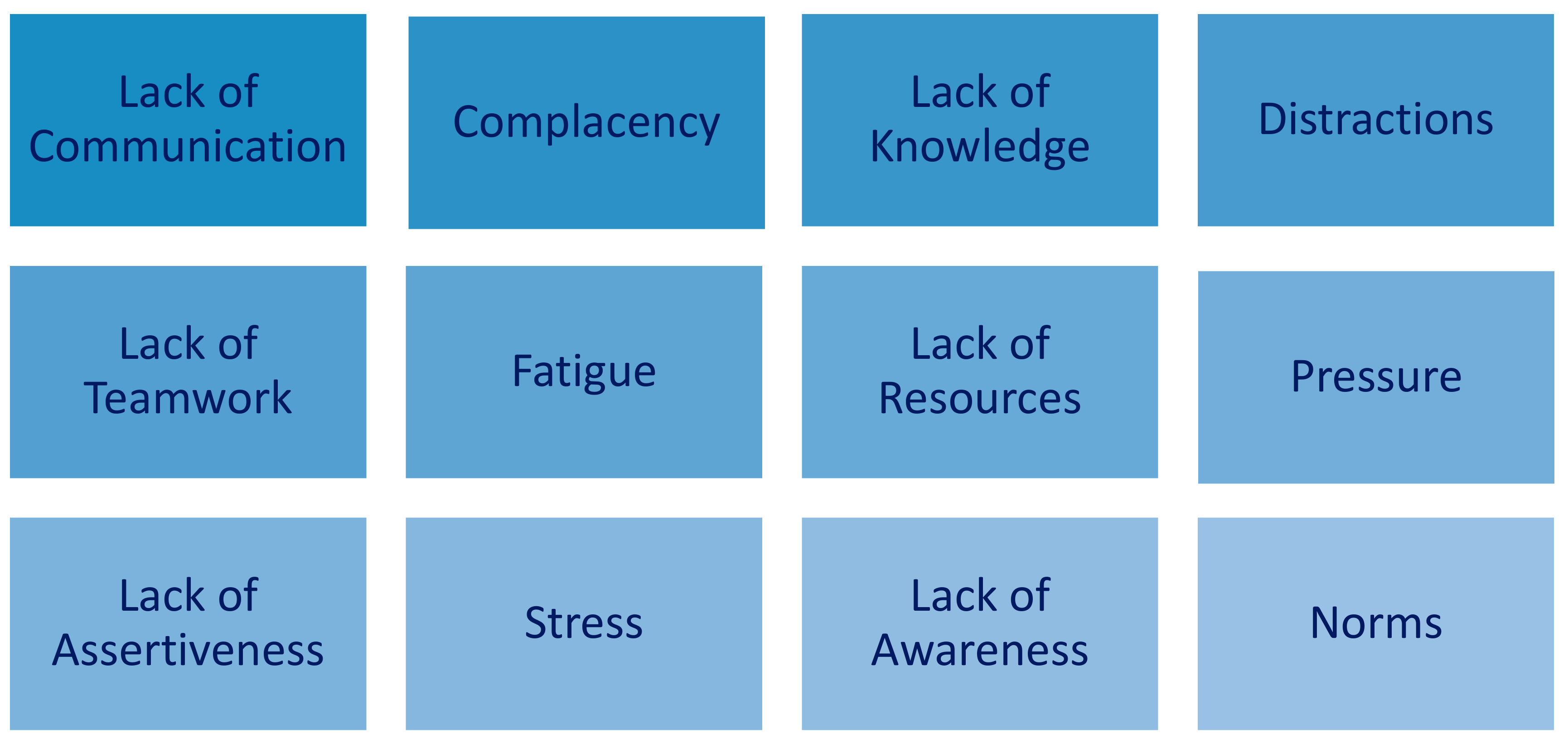
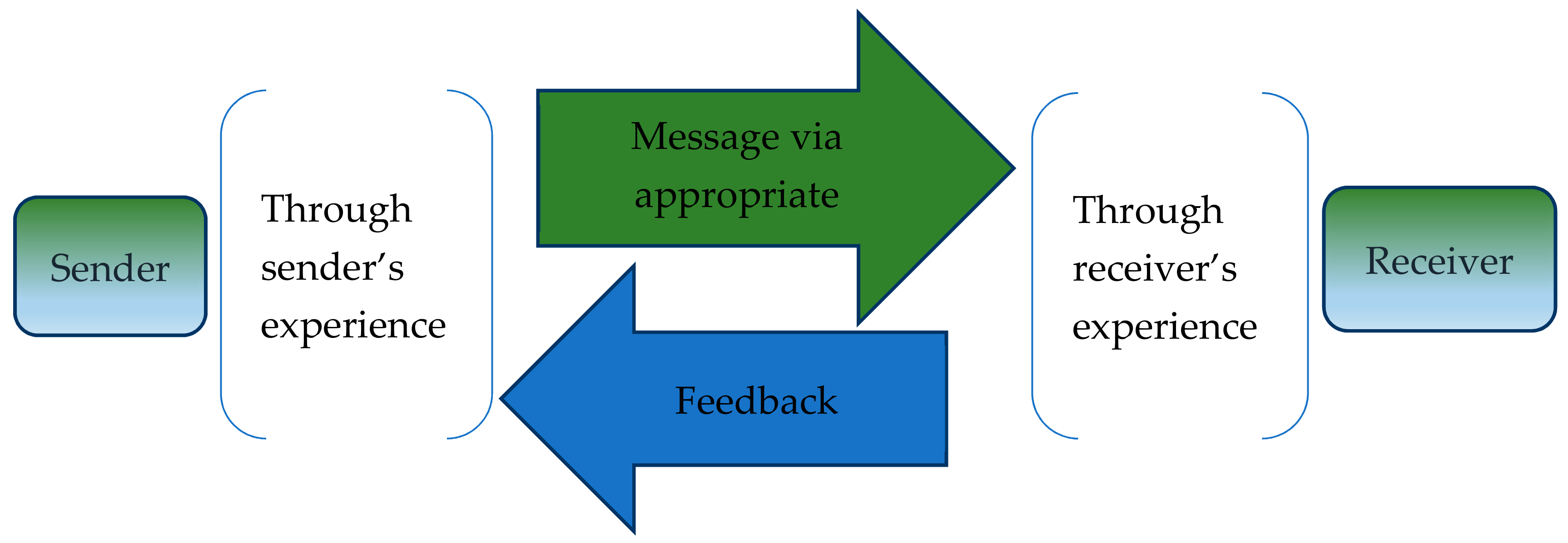

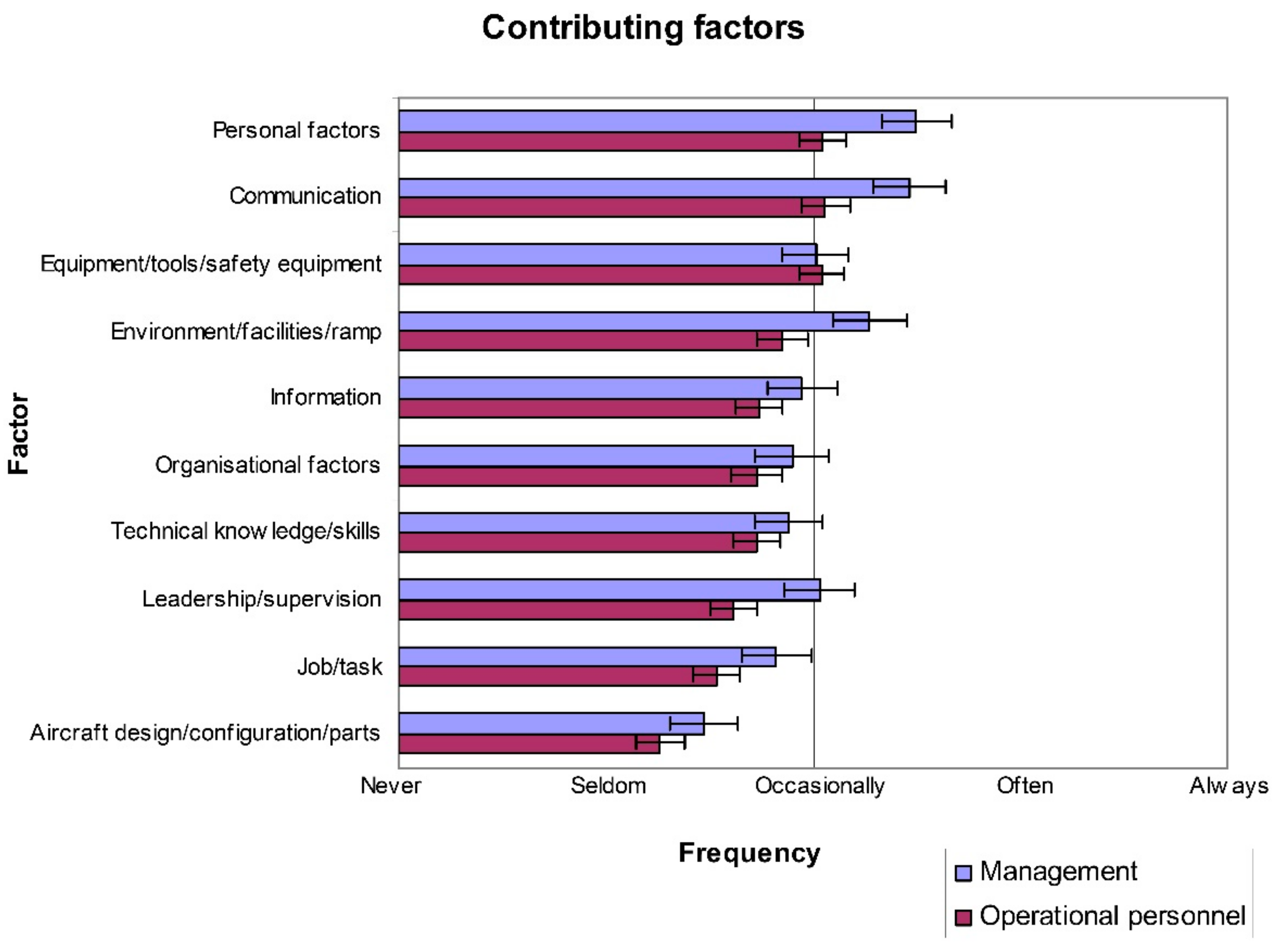
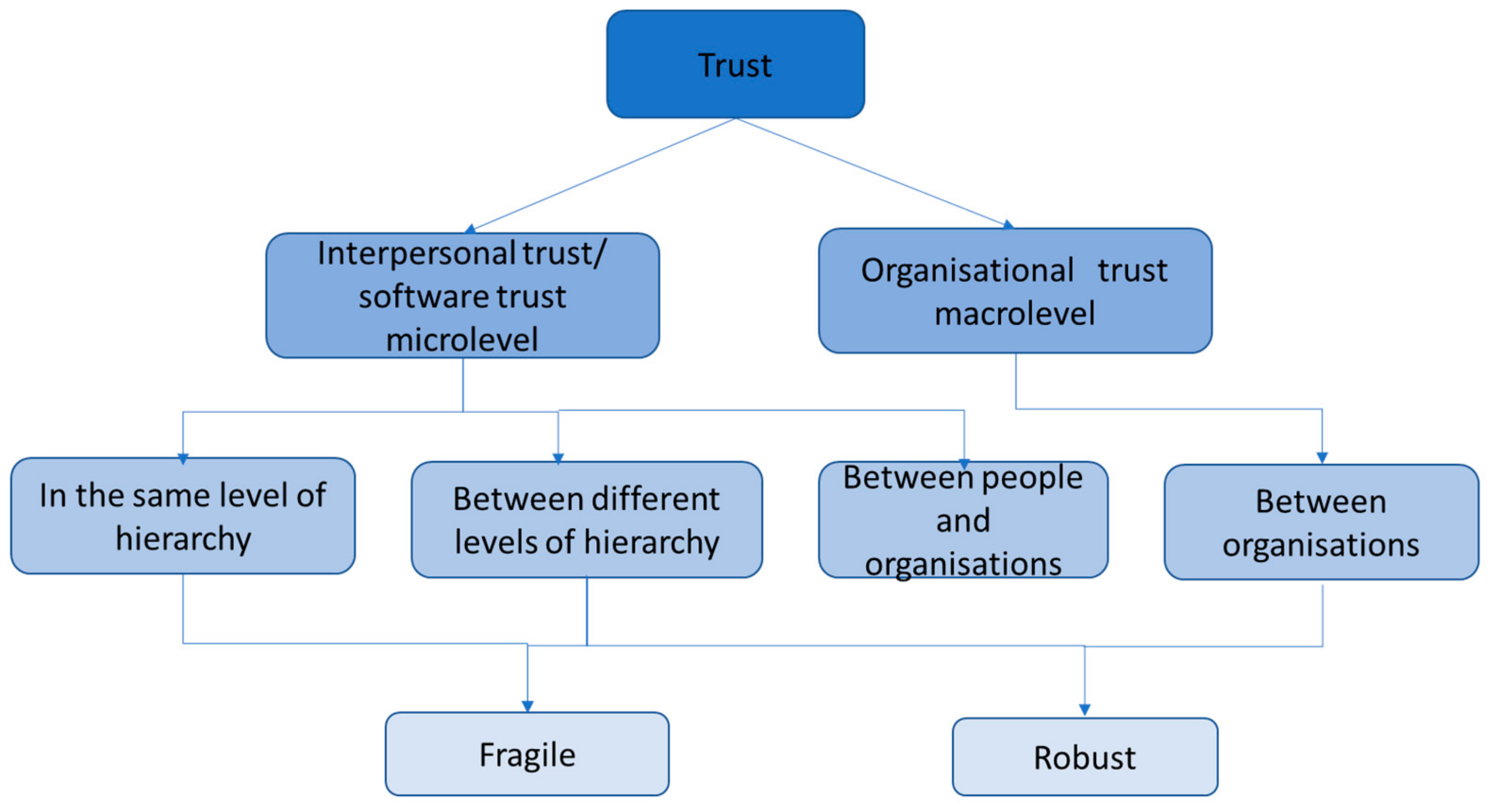
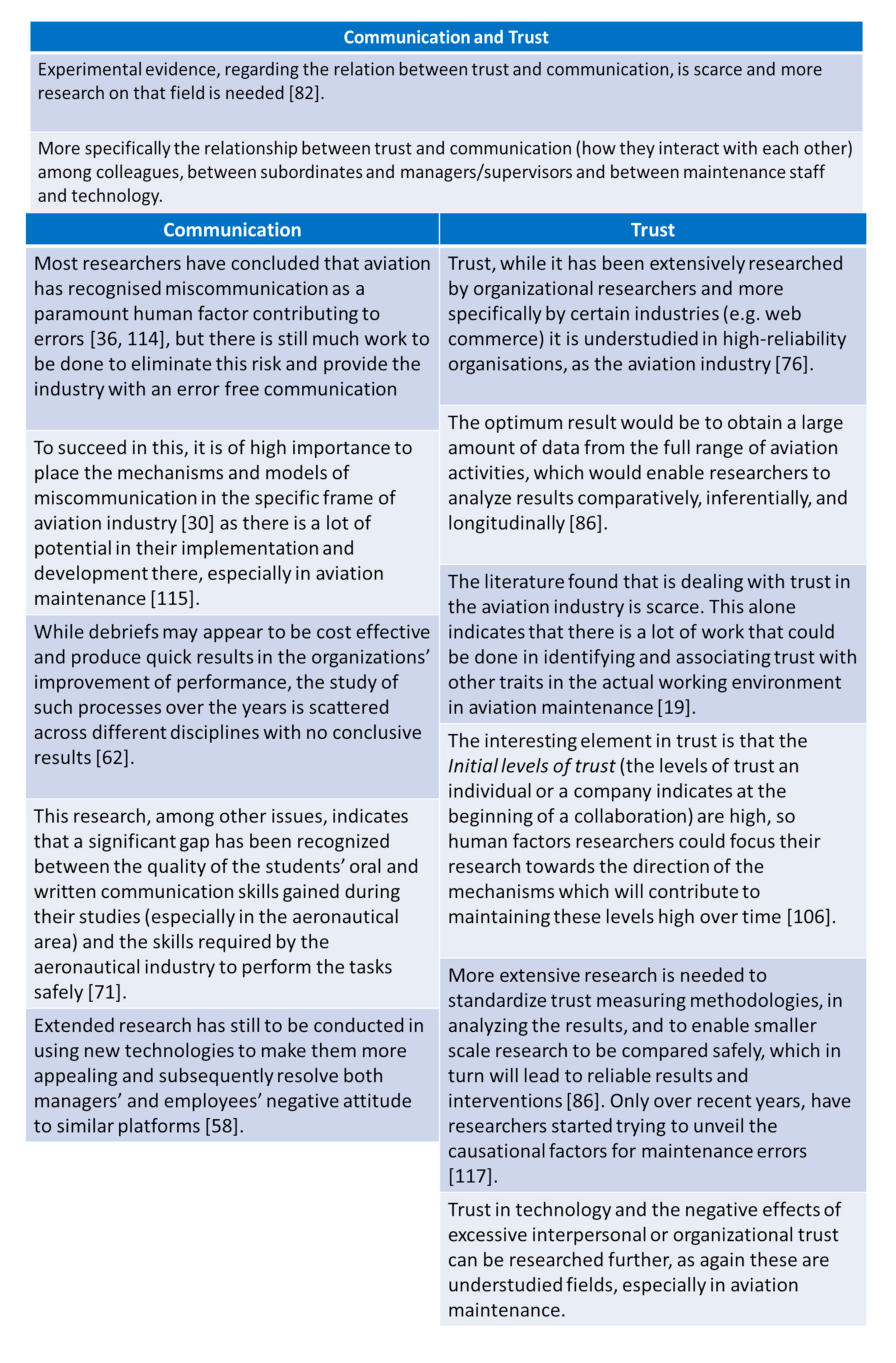
© 2019 by the authors. Licensee MDPI, Basel, Switzerland. This article is an open access article distributed under the terms and conditions of the Creative Commons Attribution (CC BY) license (http://creativecommons.org/licenses/by/4.0/).
Share and Cite
Chatzi, A.V.; Martin, W.; Bates, P.; Murray, P. The Unexplored Link between Communication and Trust in Aviation Maintenance Practice. Aerospace 2019, 6, 66. https://doi.org/10.3390/aerospace6060066
Chatzi AV, Martin W, Bates P, Murray P. The Unexplored Link between Communication and Trust in Aviation Maintenance Practice. Aerospace. 2019; 6(6):66. https://doi.org/10.3390/aerospace6060066
Chicago/Turabian StyleChatzi, Anna V., Wayne Martin, Paul Bates, and Patrick Murray. 2019. "The Unexplored Link between Communication and Trust in Aviation Maintenance Practice" Aerospace 6, no. 6: 66. https://doi.org/10.3390/aerospace6060066
APA StyleChatzi, A. V., Martin, W., Bates, P., & Murray, P. (2019). The Unexplored Link between Communication and Trust in Aviation Maintenance Practice. Aerospace, 6(6), 66. https://doi.org/10.3390/aerospace6060066




